History
The Tualatin Valley and Beaverton area was originally the home of native people called the Atfalati. Westerners later mispronounced the name Tualatin. The tribe was a hunter-gatherer group that relied more on plants than animals for their food. They made use of various plant materials for making their clothes, houses, and other personal effects. Although prosperous, the Atfalati population declined significantly starting in the late 1700s.
The Native Americans occupied a village located on the Beaverton and Fanno creeks that were called Chakeipi Although the name meant "Place of the Beaver", early settlers called the village "Beaver Dam" and this was later changed to Beaverton.
THE EXPLORERS AND PIONEERS
It was not until 1792 that westerners first visited the Pacific Northwest when American Robert Gray sailed into the Columbia River and opened the door to exploration. Later that year, British Lt. William Broughton, serving under Capt. George Vancouver explored 100 miles upriver. Along the way, he named a point of land along the shore in honor of his commander.
The first overland expedition to the northwest came when American explorers Meriwether Lewis and William Clark visited in 1806. On the return trip, they camped near what is now Vancouver, Washington. Lewis characterized the area as "the only desired situation for settlement west of the Rocky Mountains."
In the spring of 1847, the first land claim (comprising 640 acres of Beaverdam) located in what is now Beaverton was taken up by Lawrence Hall. He and his brother built a grist mill near present-day Walker Road. Their mill along with others that were soon built in the area was instrumental in supporting Oregon's early agriculture communities.
The other important industry in early Oregon was logging and wood products. Thomas Hicklin Denney and his wife Berrilla came to Oregon in 1849 and quickly established the first sawmill in what is now the Beaverton area.
As more people came into the area, it became increasingly important to provide a system of roads to transport agricultural and wood products to Portland for shipment. In 1850 the territorial government created the Portland-Tualatin Valley Plank Road Company to build plank roads from Portland to Hillsboro along Canyon Road. The road was completed as far as Beaverton by 1860 despite various financial setbacks.
THE CITY OF BEAVERTON

Spurred on by a railroad into town built in 1868, the small farming community west of Portland began to grow. By 1893 the City of Beaverton was formally incorporated with a population of 400. Alonzo Cady, a local businessman became the first mayor.
In 1872, George Betts became the City's first postmaster. The post office was located in a general store that he owned. The current post office is located on Betts street, named in honor of the first postmaster.
Beaverton's first library opened its doors in 1925 on the second floor of the Cady building. Over the years the library has been housed in several different locations. The Library was taken over by the City government in 1941 and rehoused in the old firemen's hall. Then in 1948 it was moved to a building on first street, then again in 1958 to a location on Hall street where it stayed until 1980. It was temporarily located in the Hall Street Station for four years. In 1984 the Library was moved to a different location on Allen Boulevard where it stayed for a number of years until a new Library was built at the intersection of Fifth Street and Hall Boulevard in September 2000.

